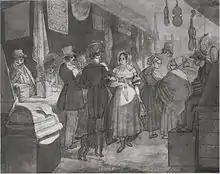Auer Dult
The Auer Dult is a traditional fair in Munich, combining a market and a German style folk festival.


It takes place three times per year on the Mariahilfplatz in the Munich district of Au, fuelled by around three hundred traders and showmen, by the rule. Both sections - market and funfair - are separated by the neo-gothic Mariahilfkirche (Mariahilf Church) in the very middle of the square. In contrast to the Oktoberfest and the Munich Spring Festival (Münchner Frühlingsfest), the Auer Dult is much less touristy, but way more local, discreet and calm. In the course of the year, around 300,000 visitors are counted.
The first fair of the year, the so-called Maidult (May fair) starts on the first Saturday of the month. Jakobidult takes place in late July and early August (beginning on the Saturday after the feast day of St. James) and Kirchweihdult occurs round the middle of October, from Saturday prior to Kirchweih till the following Sunday.[1] Each one lasts nine days.
History
Dult is an old word in East Upper German to describe a traditional fair.
Munich's Jakobidult (round St. Jacob's / James's name day, the 25. July) was first established in 1310 on the meadow on which the modern day Sankt-Jakobs Platz was established. The second fair of the year in town having been the now famous and touristy Christmas market. From 1791 the former occurred on the stretch of Kaufinger and Neuhauser streets. In 1796 Elector Karl Theodor bestowed on the nearby suburb of Au, located on a floodplain opposite town (i.e., east of the Isar) and a small village at the time, the right to hold a fair (Dult) of its own twice a year. From this came the name and necessary distinction Auer Dult. Starting in 1799, the locals held fairs in May and October, modern Maidult (May fair) and Kirchweihdult (parish fair). After Au's incorporation to the City of Munich in 1854, the Jakobidult was moved there also, creating the known triplet of events.
Except the mid and post war years of 1943-1946 and in 2020 due to Corona, the fair has taken place three times per year since 1905.
Market

The Auer Dult is considered to be the largest crockery market in Europe. Pots, porcelain and other ceramic wares are available at numerous Standl (little stands, i.e., sales booths). In addition, other household accessories, natural healing remedies and clothes are available. Many stands also offer antique books and commodities. The assortment of items ranges from chamber pots to rustic furniture.
Folk Festival


Next to the area of the Standl is a second one, where there are typical fairground rides. Until including 2019 there also used to be a small Ferris wheel, called the Russenrad (Russian's wheel). Visitors find a chairoplane, a child's roundabout, a swing boat, a horse riding track, dodgems and shooting galleries. There are also various takeaways and a beer tent which offers typical Bavarian specialities like the famous and much-beloved Steckerlfisch.
References
- www.auerdult.de. "Termine". www.auerdult.de. Archived from the original on 2016-07-30. Retrieved 2016-08-05.